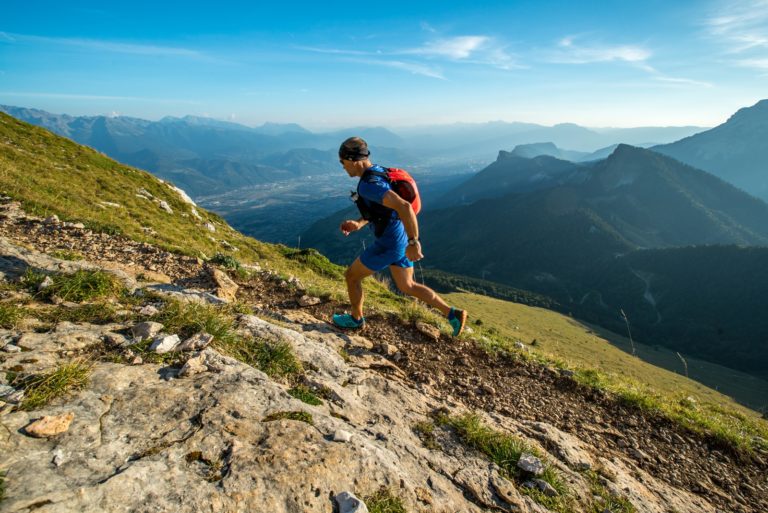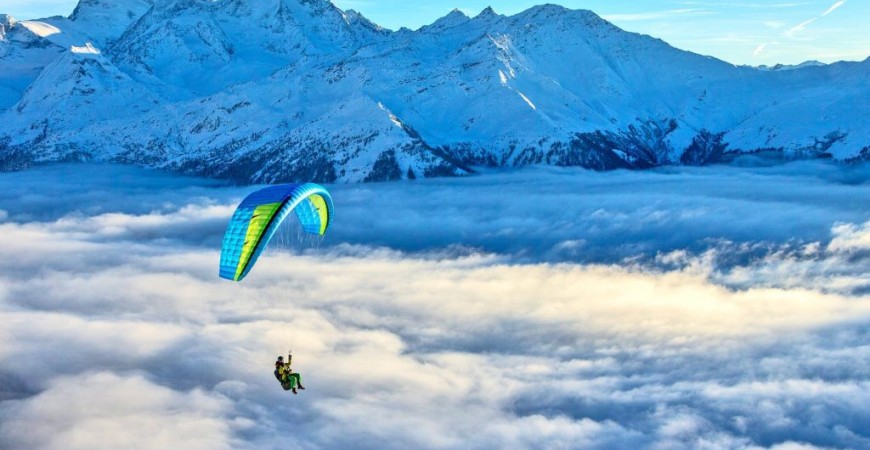SINGLE SKIN PARAGLIDING: EVERYTHING YOU NEED TO KNOW
Paragliding is a multi-disciplinary sport: Cross-country, "Hike & Fly", or "Acro", and each discipline has its own equipment. Today, we've concocted an article on one of paragliding's specialities: the single skin paraglider - everything you need to know!
WHAT IS A SINGLE SKIN PARAGLIDER?
Quite simply, it's a glider designed without the bottom part known as the "Intrados".
The study of flight mechanics has enabled manufacturers to determine the parts that are essential for a wing to fly. Aerodynamic forces are concentrated on the upper part of the leading edge, so the lower surface can be dispensed with for most of the wing.
Single skin wings are to mountain flying what BMX is to cycling. A specialized tool with its own program. And while their design means that they offer lower flying performance than single skin wings of equivalent size, they are nonetheless formidable tools for hardened sportsmen and women eager to practice trail riding, climbing, hiking... while flying back down!

THE ADVANTAGES OF SINGLE SKIN PARAGLIDERS
There are many advantages to these gliders. First, the weight! 980g for the lightest model (Run & Fly from Dudek), less than 2 kilos overall for other models (Skin 3 from Niviuk), for example. This represents a gap of over 2 to 3 kilos compared with more traditional school wings.
This difference can be explained by three factors
- Eliminating the underbody. Less material means less weight.
- The weight of the fabric. For a standard wing, the fabrics used weigh around 32 g/m², while those used for single-skin paraglider weigh more like 27 g/m².
- The construction of manufacturers who optimize the dimensions and length of the lines, as well as the surfaces of the wings.
Technically speaking, these wings are easier to access. Their light weight reduces inertia on the pitch and roll axes, which means less sink and easier re-centering than with a conventional glider. From a technical point of view, these wings offer the advantage of rapid progress, which means that, with the right training, you can get into the air quite quickly. In fact, these wings inflate with disconcerting ease! So you can spend a little less time on the school slope and go faster in the air!
One step, maybe two if you're out of shape, and HOP! The wing is over your head, ready to take off! Magic, isn't it?

Another positive point for these wings is their price. These wings are often less expensive than traditional wings, making them easier to invest in. They are also much sought-after second-hand wings, so you can limit the discount on purchase and resell them very easily.
In conclusion, as you can see, these wings are appreciated for their weight and compactness. This means you can pack light for trail running, mountaineering, ski touring, etc... And when they're tucked away at the bottom of your pack, you'll hardly feel them at all! They'll get you off the ground with ease in places sometimes unsuitable for conventional wings.
THE LIMITS OF SINGLE SKIN PARAGLIDERS
Knowing everything there is to know about single skin paragliders also means knowing their limits!
In fact, as you'll have understood, these wings are more fragile than standard paragliders. This calls for a little more meticulous maintenance, as well as appropriate use in flight. With equivalent use, the lifespan of a normal wing will be longer than that of a single skin glider. But don't panic, this isn't a disposable wing. All you need is the right practice.
Finally, the other disadvantage of these wings is their performance against the wind. Here again, we're talking about flying machines whose performance is closer to that of an airplane than an iron! Simply put, you can't expect to do long-distance flights or acrobatics with these wings. However, you'll still be able to take thermals, do a few small transitions and cover dozens of kilometers.
LEARNING TO PARAGLIDE WITH SINGLE SKIN WINGS
It's a debate that's almost irrelevant now. At the time of writing, I'm in favor of teaching with single-skin gliders, but this hasn't always been the case, simply because I had a well-defined approach to paragliding.
Thanks to the evolution of materials, manufacturers have succeeded in making these wings safer. Although generally rated EN B, a number of schools have taken the right approach to teaching paragliding with single skin wings.
The take-off phases are much easier than with standard wings, which means that you can quickly get to grips with controlling the wing on the ground. Once airborne, these wings remain very stable and maneuverable. Landings may require a bit of adapted handling, but nothing that's out of reach.
The most important point is the attitude students adopt once they leave the school. Intended for mountain flying, each student will need to assess his or her own abilities, and evaluate the weather and aerological conditions before each take-off, with even greater importance than with more conventional paragliding. The ease of use of these paragliders should in no way make you think that flying is a formality. There's always an awareness to be made before each flight, to assess whether or not it's right to take to the air.
These reflexes will be instilled in you during your introductory and/or advanced course in single-aisle paragliding. These single skin paragliding courses will teach you all you need to know!
EQUIPMENT FOR SINGLE SKIN PARAGLIDING
In paragliding, almost any type of wing will allow you to fly with any type of harness or parachute. Nevertheless, you don't see many trailers running in moccasins... And yet they work! But it's not necessarily the best choice.
Paragliding is no exception to the rule.
Harnesses
String harnesses (from 100g for the lightest to 1.2kg) will be preferred for flying these wings, as they are also the most optimized harnesses in terms of weight and compactness.
Rescue Parachute
Once again, we tend to choose light (approx. 1.2 kg) and ultra-light (approx. 1 kg) rescues, always with a view to saving weight. For the most regular paraglider pilots, the rescue even becomes cumbersome, and these pilots decide to do without a reserve parachute, a choice which is understandable if you take into account the frequency of use of the site, the aerology and the level of practice.
Bag
This will depend on the size of your pack, whether you're going on a bivouac flight, etc., but 30-liter bags may be sufficient for the most compact packs...
BUYING YOUR SINGLE SKIN PARAGLIDER ONLINE: HOW DO YOU CHOOSE?
If you've made it this far in reading this article, you've surely understood the usefulness of this type of glider for paragliding. If you're a beginner paraglider pilot looking for a paraglider that will enable you to progress quickly and serenely, single skin wings are for you! They are also ideal for more experienced pilots in search of lightness. In fact, as well as being lightweight, these gliders are easy to transport, which is particularly useful for Hike and Fly. So you can easily carry them with you in your rucksack when hiking or mountaineering. Walk up, fly down!
What's more, virtually every paragliding brand these days offers its own single skin wing. This gives paragliders a wide choice of models and designs, but also of budgets. Indeed, prices can vary greatly from one model to another. Nevertheless, as we have already seen, they are generally less expensive than conventional paragliders. Finally, there are also single skin wings designed specifically for tandem paragliding. These allow you to take a friend or family member with you on a flight, and let them discover the pleasure of flying during their first flight!
On our Air et Aventure online store, we offer several models of single skin wing. These models have been tested and validated by our expert instructors. The Skin 3p from NIVIUK is an agile and versatile glider.
To conclude, for many paragliders, single-surface wings are a second wing enabling them to practice their sport in a different way. For others, it's their main paraglider, because paragliding is an aerial sport that complements their initial sport (trail, hiking, etc.). Although requiring some adaptation, learning to paraglide using these wings is something that schools have mastered, and is much appreciated by the public.
So don't hesitate to contact us if you have any questions on the subject!
We hope you've enjoyed this article and we look forward to seeing you soon to make your wildest dreams come true! 🙂









